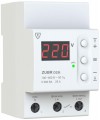Power
The rated power of the relay in kilovolt-amperes, in other words, the maximum apparent load power with which the device can normally operate.
From a physical point of view, kilovolt-amperes and kilowatts mean the same thing, but in kW it is customary to indicate only the active power of the load (see below), and in kVA — full. In AC networks, these powers can vary because active power (the power consumed by resistive-type devices such as heaters) is added to reactive power (the power consumed by capacitors and inductors). The apparent power is calculated from these two quantities.
When selecting control relays for AC networks, it is best to take into account the full power, especially if you plan to connect equipment with electric motors to the device. However, for many modern household appliances, only active power is given in the characteristics — in kilowatts. There are calculation methods that allow converting active power into total power, depending on the type and characteristics of the load; such techniques can be found in special sources.
Rated current
Rated switching current for which the control relay is set. In some models, this parameter can be changed at the request of the user; for such devices, the current value set in the factory settings is indicated (usually, this is the maximum indicator).
For a voltage relay (see “Device”), the rated current is the maximum current allowed for the device and the network segment protected by it for an unlimited time, in fact, the maximum current in normal operation. Exceeding this current is allowed, but not for long (up to several minutes) and not much, not higher than the maximum current (see below). And devices with the functions of a current relay or a power relay can work as follows: if the actual current is between the rated and maximum, the relay goes into the “delayed off” mode, and turns off the power after a certain period of time (for example, 10 minutes). This avoids both overload from long-term operation at high currents, and unnecessary power outages at large, but short-term permissible loads.
Maximum current
Maximum switching current allowed for the control relay. This is the maximum current that the device can safely pass through itself. And for models with current relay functions (see "Device"), this is also the default threshold of instantaneous operation — the current at which the relay instantly turns off the power to the load. In many models, you can set a lower threshold, but not a higher one.
Functions
—
Display. As a rule, control relays are equipped with simple segment LCD displays that can display numbers and some special characters. This screen performs two main functions. Firstly, during operation it displays key network parameters - voltage, power and/or power, as well as notifications of problems; Some models provide several separate displays, each with its own parameter. Secondly, the screen is used when changing device settings.
—
Operation indicator. A pointer indicating the operation of a device, and often a specific mode of operation. Note that in this case we are talking about the simplest indicators - for example, in the form of an LED, which lights up green in normal mode and lights up red after the protection is triggered. The display is not considered an operation indicator, although it can perform such a function.
—
Thermal protection. A safety system that turns off the device when it reaches a critical temperature. Some models also provide a shutdown when the permissible heating rate is exceeded. This function serves as additional insurance in case of malfunctions in the relay itself (for example, if the settings are lost and the device does not respond to overload), and in case of fire (in case of fire, the equipment must be de-energized).
—
Memory of emergency operations. The function
...of saving data on the state of the network during emergencies. Allows you to assess the situation of what happened after resuming work.
